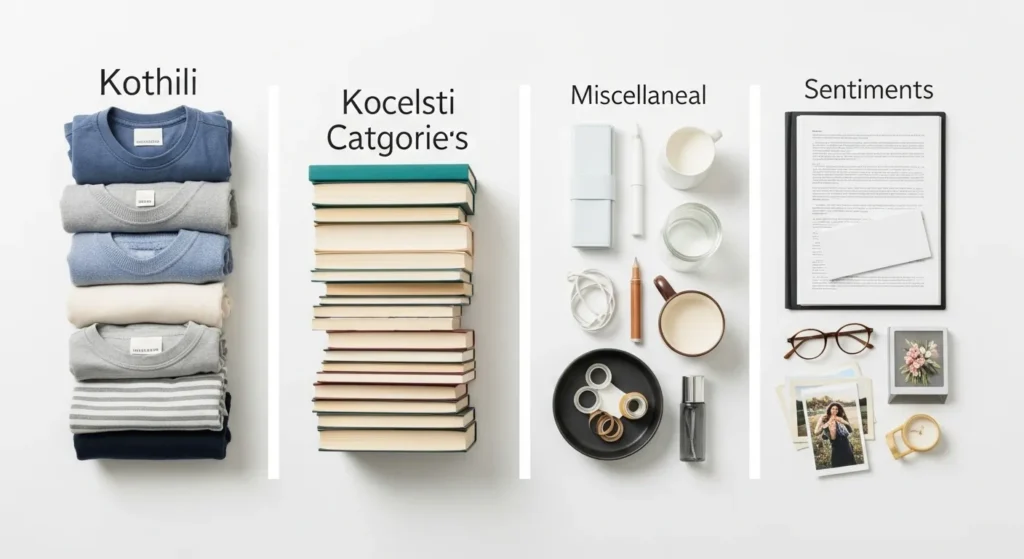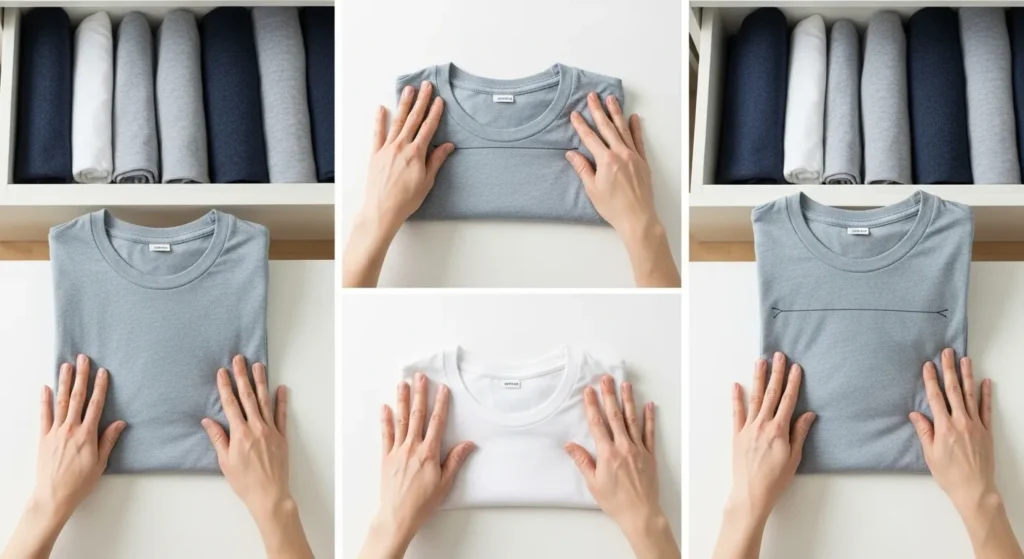The KonMari Method promises to help you declutter your home once and for all. Created by Japanese organizing consultant Marie Kondo, this approach focuses on keeping only items that “spark joy.” This guide breaks down the method step-by-step, making it easy for anyone to start their tidying journey.
What Is the KonMari Method?
The KonMari Method is a decluttering system that teaches you to organize by category instead of room. Marie Kondo developed this technique after studying tidying methods for years. Her approach became famous worldwide after her book “The Life-Changing Magic of Tidying Up” became a bestseller in 2014.
The method centers on one simple question: “Does this spark joy?” You hold each item and decide whether it brings you happiness. If yes, you keep it. If no, you thank the item for its service and let it go.
Core principles:
- Organize by category, not by room
- Handle every item individually
- Keep only what sparks joy
- Follow a specific order of categories
- Complete the process in one focused effort

The 5 Categories of the KonMari Method
Marie Kondo insists you must follow these categories in exact order. Each category prepares you for the next, building your decision-making skills as you progress.
Category 1: Clothes
Start with clothing because these decisions are usually easiest. Gather all clothes from every room, closet, and laundry basket.
Steps:
- Collect all clothing items in one place
- Pick up each piece individually
- Ask “Does this spark joy?”
- Keep items that make you happy
- Thank discarded items before donating
What to look for:
- Clothes you love wearing
- Items that fit your current lifestyle
- Pieces that make you feel confident
- Quality over quantity
Category 2: Books
Books often hold sentimental value, making them harder to part with than clothes. Focus on books you’ll realistically read again or reference frequently.
Keep these books:
- Reference materials you use regularly
- Books you plan to reread
- Volumes with special meaning
- Professional or educational resources
Let go of:
- Books you didn’t finish and won’t try again
- Outdated information books
- Duplicates or similar content
- Books you keep “just in case”
Category 3: Papers
Most papers can be discarded immediately. Keep only what you truly need for legal or practical reasons.
Essential papers to keep:
- Tax documents (7 years)
- Insurance policies
- Legal documents
- Warranties for current appliances
- Medical records
Discard these papers:
- Old utility bills
- Expired warranties
- Outdated manuals
- Credit card offers
- Most receipts over one year old
Category 4: Komono (Miscellaneous Items)
This category includes everything else: kitchen items, toiletries, electronics, office supplies, and decorative objects.
Subcategories to tackle:
- Kitchen utensils and gadgets
- Bathroom products
- Electronics and cables
- Office and craft supplies
- Cleaning products
- Home decor items
Work through one subcategory at a time to avoid feeling overwhelmed.
Category 5: Sentimental Items
Save sentimental items for last because they require the strongest joy-detection skills. These items often carry memories and emotions.
Common sentimental items:
- Photos and albums
- Letters and cards
- Souvenirs and gifts
- Childhood keepsakes
- Family heirlooms
- Artwork and crafts
Take your time with this category. Your joy-sensing abilities will be strongest by this point.

How to Know If Something Sparks Joy
Learning to recognize joy takes practice. Marie Kondo describes it as a warm, happy feeling when you hold an item. Your body will tell you the answer if you listen carefully.
Physical signs of joy:
- Feeling lighter or happier
- Smiling when you see the item
- Excitement about using it
- Warmth in your chest
- Natural urge to hold it closer
Signs something doesn’t spark joy:
- Feeling heavy or tired
- Wanting to put it down quickly
- Indifference or boredom
- Guilt about not using it
- Memories of negative experiences
Practice exercise: Hold your favorite piece of clothing. Notice how it feels. This is your joy baseline. Now hold something you dislike wearing. The contrast will help you recognize the difference.
The KonMari Folding Method
Marie Kondo’s folding technique keeps clothes neat and visible. Each item stands upright in drawers, making everything easy to see and access.
Basic Folding Steps
For t-shirts:
- Lay shirt face down
- Fold one side toward center
- Fold sleeve back
- Repeat on other side
- Fold bottom up to create rectangle
- Fold in half again to stand upright
For pants:
- Fold lengthwise along crease
- Fold bottom hem to waistband
- Fold in half again
- Stand upright in drawer
For underwear and socks:
- Fold into small rectangles
- Store standing up in dividers
- Avoid balling socks together
Benefits of KonMari folding:
- See all clothes at once
- Prevents wrinkles
- Maximizes drawer space
- Maintains clothing shape
- Makes selecting outfits easier
Storage Solutions for the KonMari Method
Just like organizing your closet in small spaces, proper folding techniques make the most of your storage area.

Proper storage keeps your joy-filled items organized and accessible. Marie Kondo recommends using what you already own before buying new organizers.
DIY Storage Ideas
Repurpose household items:
- Shoe boxes for drawer dividers
- Small containers for office supplies
- Mason jars for bathroom items
- Baskets for miscellaneous objects
- Empty tissue boxes for cables
Vertical storage principles:
- Store items standing up when possible
- Use drawer dividers to prevent sliding
- Group similar items together
- Keep frequently used items at eye level
- Label containers for family members
When to Buy Storage Solutions
Only purchase organizers after completing the decluttering process. You’ll know exactly what storage you need and how much space you have.
Recommended purchases:
- Drawer dividers for folded clothes
- Clear containers for small items
- Shelf dividers for books
- File folders for important papers
- Storage boxes for sentimental items
Common KonMari Method Mistakes
Avoid these pitfalls to succeed with the KonMari Method:
Mistake 1: Starting with Sentimental Items
Sentimental items require the strongest joy-detection skills. Starting here leads to decision fatigue and quitting early.
Solution: Always follow the five-category order exactly as prescribed.
Mistake 2: Organizing by Room Instead of Category
Room-by-room organizing creates endless cycles of reshuffling items between spaces.
Solution: Gather all items from one category throughout your entire home before starting.
Mistake 3: Keeping Items “Just in Case”
Fear-based keeping prevents you from experiencing the joy of a clutter-free space.
Solution: Trust that you can replace truly necessary items if needed later.
Mistake 4: Rushing Through the Process
Quick decisions often lead to regret and re-cluttering.
Solution: Take time to hold each item and really feel whether it sparks joy.
Mistake 5: Not Thanking Discarded Items
This step helps you let go without guilt and appreciate items’ past service.
Solution: Develop a brief gratitude practice for items you’re releasing.
Benefits of the KonMari Method
People who complete the KonMari Method report significant improvements in various life areas:
Immediate benefits:
- Cleaner, more organized living spaces
- Easier maintenance and cleaning
- Less time spent searching for items
- Reduced stress and anxiety
- Better sleep in peaceful bedrooms
Long-term changes:
- Improved decision-making skills
- Greater appreciation for possessions
- Less impulse buying
- Enhanced focus and productivity
- Stronger connection to personal values
Psychological benefits:
- Increased self-confidence
- Better understanding of personal preferences
- Reduced guilt about possessions
- Greater mindfulness in daily life
- Improved relationships with family members
KonMari Method for Different Life Situations
The method adapts to various living situations and family dynamics:
Small Spaces
Limited space makes the KonMari Method even more valuable. Every item must earn its place through joy.
Small space tips:
- Be extra selective about joy-sparking items
- Use vertical storage solutions
- Choose multi-purpose items when possible
- Regular maintenance becomes crucial
- Consider seasonal item rotation
Families with Children
Teaching children the KonMari Method builds valuable life skills while maintaining household order.
Family approaches:
- Let children sort their own belongings
- Explain joy in age-appropriate terms
- Make it fun with music or games
- Celebrate successful decluttering
- Lead by example with your own items
Shared Living Spaces
Roommates or partners need agreement and boundaries when applying the method to shared areas.
Shared space guidelines:
- Focus only on your personal belongings
- Discuss shared item decisions together
- Respect others’ joy-sparked items
- Create individual storage areas
- Lead by example rather than pressuring
Maintaining Your KonMari Results
Completing the method once should prevent major re-cluttering, but daily habits maintain your progress:
Daily habits:
- Return items to designated homes immediately
- Apply the joy test to new purchases
- Do quick tidying sessions before bed
- Handle papers immediately when possible
- Practice gratitude for your belongings
Weekly maintenance:
- Review surfaces for accumulated items
- Address any category that needs attention
- Donate items that no longer spark joy
- Check that storage systems still work
- Celebrate your organized spaces
Monthly check-ins:
- Assess if your storage needs have changed
- Update seasonal clothing rotations
- Review paper filing system
- Consider if any categories need refreshing
- Appreciate your progress and growth
Comparing KonMari to Other Organization Methods
Understanding how KonMari differs from other systems helps you choose the right approach:
Traditional Room-by-Room Method
Pros: Familiar approach, visible progress room by room Cons: Items get shuffled between spaces, never truly decluttered
Minimalism Movement
Pros: Extreme simplicity, very little to maintain Cons: May be too restrictive, ignores personal joy
Swedish Death Cleaning
Pros: Considerate of family burden, practical approach Cons: Focus on death rather than life, less joyful process
30-Day Minimalism Game
Pros: Gradual approach, social media support Cons: Arbitrary numbers, doesn’t address root causes
Why KonMari works better:
- Addresses emotional attachment to items
- Teaches valuable decision-making skills
- Creates lasting change rather than temporary fixes
- Focuses on positive feelings rather than restriction
- Provides clear structure and methodology
Scientific Research on Decluttering Benefits
Studies support many claims about decluttering’s positive effects:
UCLA research findings:
- Cluttered homes increase cortisol levels
- Women in messy homes show more depression
- Organized spaces improve focus and productivity
- Clear surfaces reduce decision fatigue
Harvard Business School study:
- Organized workspaces increase healthy eating
- Clean environments promote better choices
- Physical order supports mental clarity
- Reduced clutter improves sleep quality
Princeton Neuroscience Institute:
- Visual clutter competes for attention
- Organized spaces improve information processing
- Clear environments reduce stress hormones
- Tidy spaces enhance creative thinking
Budget-Friendly KonMari Implementation
You don’t need expensive organizers to succeed with the KonMari Method:
Free organization tools:
- Cardboard boxes from deliveries
- Empty jars and containers
- Repurposed shopping bags
- Folded paper dividers
- Found baskets and bins
Low-cost purchases:
- Dollar store containers
- Thrift shop organizational items
- Basic drawer dividers
- Simple label maker or tape
- Inexpensive hangers
Money-saving benefits:
- Reduced impulse purchases
- Better use of existing items
- Less duplicate buying
- Appreciation for quality over quantity
- Selling valuable discarded items
Similar to choosing eco-friendly cleaning products, the KonMari Method often uses items you already own rather than requiring expensive purchases.
Seasonal Considerations for KonMari
Different seasons present unique opportunities for KonMari maintenance:
Spring Cleaning Connection
Spring naturally inspires decluttering and fresh starts. Use this energy for your KonMari journey.
Spring activities:
- Address winter clothing storage
- Refresh bathroom and cleaning supplies
- Review gift accumulation from holidays
- Update paper filing systems
- Donate winter items that didn’t spark joy
Summer Preparation
Warmer weather brings different clothing needs and outdoor activities.
Summer focus:
- Rotate seasonal wardrobes
- Organize outdoor equipment
- Address vacation gear
- Review summer entertaining supplies
- Prepare efficient cooling strategies
Fall Organization
Back-to-school energy and holiday preparation create natural organizing momentum.
Fall priorities:
- Establish school and work routines
- Prepare for holiday decorating
- Review and update gift lists
- Organize craft and hobby supplies
- Create cozy, welcoming spaces
Winter Maintenance
Indoor time during colder months offers opportunities for maintenance and reflection.
Winter activities:
- Deep clean organized spaces
- Address holiday gift integration
- Review the year’s acquisitions
- Plan spring organizing projects
- Appreciate your organized, peaceful home
Teaching Children the KonMari Method
Children can learn joy-based decision making from an early age:
Age-appropriate approaches:
Ages 3-6:
- Use simple “happy” or “sad” choices
- Let them hold toys and clothes
- Celebrate their good decisions
- Keep sessions very short
- Focus on obvious preferences
Ages 7-12:
- Introduce the word “joy”
- Explain the five categories
- Let them lead their own sorting
- Teach proper folding techniques
- Connect organizing to responsibilities
Ages 13+:
- Discuss values and identity
- Allow independent decision-making
- Support their personal style choices
- Connect organizing to life skills
- Respect their joy-sparked items
Benefits for children:
- Improved decision-making abilities
- Better care for belongings
- Reduced materialism
- Enhanced self-awareness
- Stronger organization skills
Digital Decluttering with KonMari Principles
The joy principle applies to digital possessions too:
Digital categories to address:
- Photos and videos
- Documents and files
- Apps and software
- Email and messages
- Social media connections
Digital joy questions:
- Does this photo make me smile?
- Do I use this app regularly?
- Does this file serve a current purpose?
- Does this social connection add value?
- Does this subscription bring enjoyment?
Digital organization tips:
- Create simple folder structures
- Delete duplicates and blurry photos
- Unsubscribe from unused services
- Organize files by project or date
- Back up truly important items
Long-Term Success Stories and Results
Real people share their KonMari transformations:
Common success patterns:
- Initial resistance followed by breakthrough moments
- Surprising discoveries about personal preferences
- Improved relationships and family dynamics
- Career changes and life direction shifts
- Sustained organization over years
Maintenance strategies from successful users:
- Annual category reviews
- Gift-giving boundary setting
- Teaching method to family and friends
- Connecting organization to personal values
- Celebrating organized spaces regularly
Life changes reported:
- Moving to smaller homes by choice
- Starting new careers or businesses
- Improving financial management
- Developing stronger relationships
- Finding more time for meaningful activities
Environmental Impact of Thoughtful Decluttering
The KonMari Method supports environmental responsibility through mindful consumption:
Environmental benefits:
- Reduced waste through careful keeping decisions
- Donation of usable items to others
- Decreased impulse buying and overconsumption
- Better appreciation for quality over quantity
- Longer use of joy-sparking possessions
Sustainable disposal practices:
- Research proper recycling for electronics
- Donate books to libraries and schools
- Give clothing to appropriate charities
- Compost natural material items when possible
- Sell valuable items rather than discarding
Future consumption changes:
- Questioning purchases before buying
- Investing in higher quality items
- Choosing experiences over possessions
- Supporting businesses aligned with values
- Teaching others about mindful consumption
Conclusion
The KonMari Method offers more than organization – it teaches you to recognize and surround yourself with joy. By following the five categories in order and keeping only items that spark happiness, you create spaces that support your best life.
Start with clothes to build your joy-detection skills. Take time with each item. Trust your instincts. The process may feel overwhelming at first, but thousands of people worldwide have successfully completed it.
Remember that this is about discovering what brings you joy, not following someone else’s idea of perfect organization. Your joy-sparked items will be different from others, and that’s exactly the point.
Begin today by gathering all your clothes in one place. Hold each piece and ask honestly: “Does this spark joy?” Trust your answer and take the first step toward a more organized, joyful life.
The KonMari Method works because it addresses the emotional reasons behind clutter while teaching practical skills for lasting organization. Your future self will thank you for starting this transformative journey.
